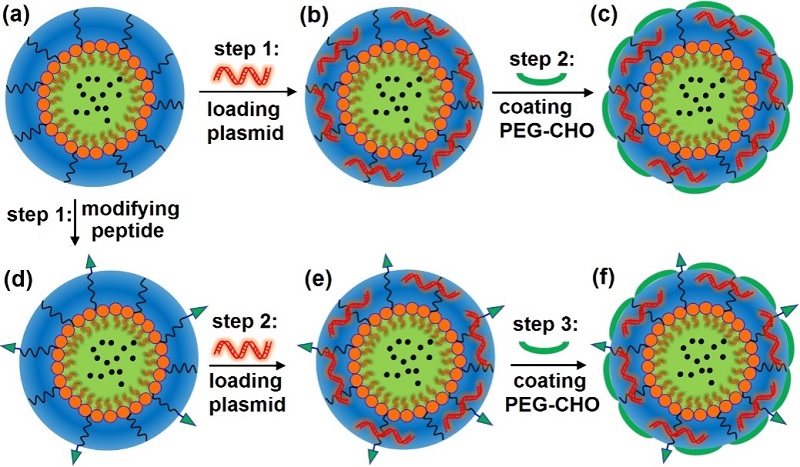Time:2019-10-09
On September 24, 2019, the research team led by Dr. WANG Zheng and Dr. QIU Zilong at the Center for excellence in Brain Science and Intelligence Technology (Institute of Neuroscience), Chinse Academy of Sciences, jointly reported that PEGylation on the surface of positively charged magnetic poly(lactic-co-glycolic acid)-polyethylenimine (PLGA-PEI) nanoparticles reduced neurotoxicity, and this biocompatible nano-gene delivery vector also enhanced the transfection efficiency in primary hippocampal neurons under magnetofection condition.
Safe and effective gene therapy is considered a promising strategy for regulating cell function and developing therapeutic treatments for brain diseases. However, it is notoriously challenging to transfect into the post-mitotic primary neurons because of restricted breakdown of the nuclear envelope. Here magnetic polymeric nanoparticles, MNP-PLGA-PEI, were developed for the utility of gene delivery. PEI with higher density of amino groups can be conjugated with negatively charged MNP-PLGA via electrostatic interaction to achieve positively charged nano-gene carrier. And, amphipathic PEG polymer with aldehyde groups can be modified on the surface of MNP-PLGA-PEI nanoparticles through Schiff base reaction to achieve PEGylated MNP-PLGA-PEI nanoparticles. The synthesis process was illustrated in Figure 1.

Figure 1. Synthesis process of nano-gene delivery system. (a) magnetic PLGA-PEI nanoparticles; (b) DNA-loaded magnetic PLGA-PEI nanoparticles; (c) PEGylated magnetic PLGA-PEI nanoparticles; (d) Peptide-modified magnetic PLGA-PEI nanoparticles (peptide-NPs); (e) DNA-loaded peptide-NPs; (f) PEGylated DNA-loaded peptide-NPs.
After systematic evaluation, our results showed that PEGylation on the surface of MNP-PLGA-PEI nanoparticles with higher cellular uptake efficiency shielded the surface charge of MNP-PLGA-PEI nanoparticles and had lower neurotoxicity, thereby preventing perturbation of intracellular calcium homeostasis. Furthermore, increased gene transfection efficiency in primary hippocampal neurons was found using PEGylated MNP-PLGA-PEI nanoparticles under an external magnetic field.
This work entitled “Effect of PEGylated Magnetic PLGA-PEI Nanoparticles on Primary Hippocampal Neurons: Reduced Nanoneurotoxicity and Enhanced Transfection Efficiency with Magnetofection” was published online in ACS Applied Materials & Interfaces. This work was completed by Dr. CUI Yanna with the help of Dr. LI Xiao, Kristina ZELJIC and Dr. SHAN Shifang, under the supervision of Profs. WANG Zheng and QIU Zilong. It was funded by the National Key R&D Program of China, the Strategic Priority Research Program of Chinese Academy of Science, Shanghai Municipal Science and Technology Major Project, grants from National Natural Science Foundation, and Major Basic Research Program of Shanghai.
 附件下载:
附件下载: